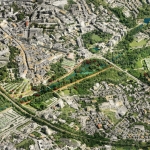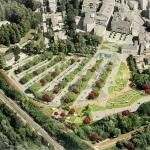The new Pordenone plan, in line with policy guidelines, becomes a project for the regeneration of the entire city.
The stagnation of the urban growth generated by the economic crisis and the resulting lack of development scenarios, require a new approach able to valorise the resources and the energies of the city.
In the past, plans were managing the growth of cities while today they must reinterpret their function, enabling new economic sectors and sustainable urban development.
The interventions of the new Pordenone Plan were set according to 3 strategic assets to be activated on the territory:
The first asset is the use of environmental technologies. Pordenone territory is rich in renewable resources that can become the driving force for a new urban development strongly oriented toward energy independence.
The new Plan examines the issue of the exploitation of water as a source of semi-collective power; on the one hand it aims to the ecological recovery of the Noncello River and on the other to energy production through the use of waterfalls and semi-collective use of heat pumps.
The second asset relates to the housing stock. The setting of the Plan through the “geoenergetic paper” and the “paper of energy consumption in buildings” identifies priority areas of the city on which to plan the first steps of regeneration.
The third asset are the abandoned areas, such as cotton mills. The plan promotes rules that simplify and accelerate the upgrades of urban brownfields through making them safe. In the transition period while the final transformation is carried out, these areas can accommodate temporary functions for leisure, become power plants with renewable energy, implement policies of naturalization to increase urban biodiversity.
Italiano










